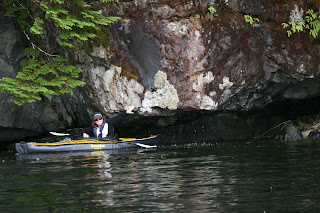Chris and I had a date night two evenings ago. Juliet was spending the night at a friend’s
house so we had the opportunity to spend some time alone. Having just come home from a long day reefing
out seams on Pacific Yellow Fin, I
needed a shower pretty badly. So I head
forward to crack open the hot water.
Nothing. Not even a drip.
Chris hollered forward that Juliet shut off the pressure
water pump because it was running continuously.
Before she’d even said that, I knew we were out of water. I’d actually known for a few days that we
were getting low, because Kwaietek was telling me. She was riding high at the
bow, and I could feel the “uphill climb” in the sole (floor) as I would walk
forward. She was also livelier in a
southeast wind. Lastly, I knew that it
had been about two weeks since I’d last filled the tanks.
As a family of three we go through the 350 gallon freshwater
tankage in about two weeks. That covers
all of our cooking, washing, cleaning and showers. It works out to about 50 gallons per person
per week. The average consumption in
this country is about 100 gallons per person per day. We’re not doing too badly. Careful use and low flow faucets and shower
heads help a lot.
This however does not cover our laundry, as we take that to
a laundry mat. When the galley is
rebuilt, I already have a high efficiency single unit washer/dryer that uses
about 7 gallons per load. It will be
installed under the countertop. We
should be running about five loads a week, including my work clothes and we’ll
still be way under the national average.
The fresh water also doesn’t cover is the head
(toilet). When we rebuilt the forward
end, I purchased a high efficiency, electric macerating head. It uses about a pint and a half per flush,
but it uses seawater. The head flushes
into a 45 gallon holding tank in the bilge under our stateroom. (As you can imagine, proper odor-proof
plumbing, tight fittings and a bomb-proof installation it paramount when living
so close to the “black water”). When I
installed the system, it took a few tweaks to get everything tight.
So where does the black water go when the tank is full? Bellingham
The amazing part about it is how few people actually use the
cart. There are at least nine boats on
the dock that have people onboard regularly.
Theoretically, they should all be pumping out to the cart. For the first few weeks I was doing this, I
would find the cart exactly as I left it.
Our neighbor asked me how to use the cart, as he had never touched
it. I actually had a guy a few slips
down ask me what I was doing with that big "carpet cleaner".
So that means all the other boats are pumping directly
overboard. I say again, that’s just
gross. Now I don’t mind direct discharge
in open water where things will dilute and flush on the tide, but not in the
marina. We have occasionally walked down
the dock when one of the fishboats in pumping overboard and the smell is most
definitely “ripe”.
However, we’ve got two new couples with small children on
the dock and a small club is being formed.
It seems that every Sunday, we’re all pumping our black water tanks,
utilizing the cart. We all joke about
the romantic lifestyle of the live-aboard, and we all wonder why more people
don’t just do the right thing. It’s really pretty easy.























